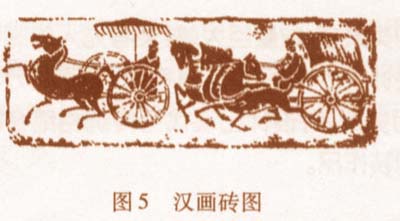Integration of Chinese Traditional Patterns in Packaging Design
1.4 Chinese painting brick
The brick paintings of the Han Dynasty and the stone carvings of the Han Dynasty are the decorative paintings carved on the bricks and then burned. The stone carvings of the portraits flourished in the Han, Wei, Six Dynasties and Tang Dynasty. There was a kind in the Han Dynasty. Loyalty will come from dutiful sons. In other words, the descendants of the deceased, in order to express their loyalty and filial piety, went up to the emperor and went down to the landlord and wealthy merchants. They did not hesitate to spend huge sums of money to build tombs and asked artisans to make drawings on the bricks. The rise of the thick burial wind in the Han dynasty led to a continuous increase in the art of stone relief paintings, which was the highest peak of the stone carvings of the portraits. The stone carvings of the Han Dynasty have become the representative works of stone carvings in the past. Therefore, the later portraits are often referred to as “Han Stone Carvingsâ€.
The main contents of Stone Carvings are: historical figures, mythological stories, social production and living conditions, as well as depicting the deceased's predecessors' achievements, life experiences, and post-mortem ascension, chanting the “old sagesâ€, such as Fuxi, Shennong, Zhougong, and Confucius. And so on; there are performances such as "Ranger", "Yoshishi", "Harvest Girl" and so on. As shown in Figure 5. The entire art style is concise and earthy, vivid and beautiful, changing the natural image into a pattern image.

1.5 Party Winner [3]
Eight auspicious, one of eight kinds of Buddhist objects (falu, law wheel, umbrella, white cover, lotus, aquarium, goldfish, plate length). The “lawrence descriptive book of the Lama Temple†contains: “The length of the disc, the Buddha said that the ring will carry out all that is clear.†It was widely used in the Ming and Qing dynasties, and it contained auspicious meanings and symbols. Patterns are used in a wide range of applications, including quadruple disk length, Bandai disk length, and Fang Shengpanchang. People often call it a "Chinese knot." The sentiments and wisdom displayed on it are one aspect of ancient Chinese civilization.
The meaning of Chinese knots is as much as other Chinese arts use natural forms and homophonic meanings. For example, the combination of "Ki-zi knot", "Xinjie" and "fish knot" will become "Ji Qing Yu Yu" knot jewelry, with " Bat knots and "money knots" can form "blessings" and so on. By analogy, the connotations of blessings such as "longevity and well-being", "rich goods", "happy reunion", "happy auspiciousness" and "happy joy" have been extended. They have been used as symbols of folk prayers and have become auspicious ornaments handed down from generation to generation.
There is also a kind of legal material that is considered to be a deity in China. It can achieve the effects of exorcism, arrogance, and ignorance, such as “good luck knots†and “long knotsâ€. This "knot" is a talisman that embodies the mystical religious concept. It has been widely used by the people and forms a certain inheritance mechanism.

(to be continued)
Shuibao Mosquito Netting & Canopy Textiles Inc. , http://www.canopy-manufacturers.com